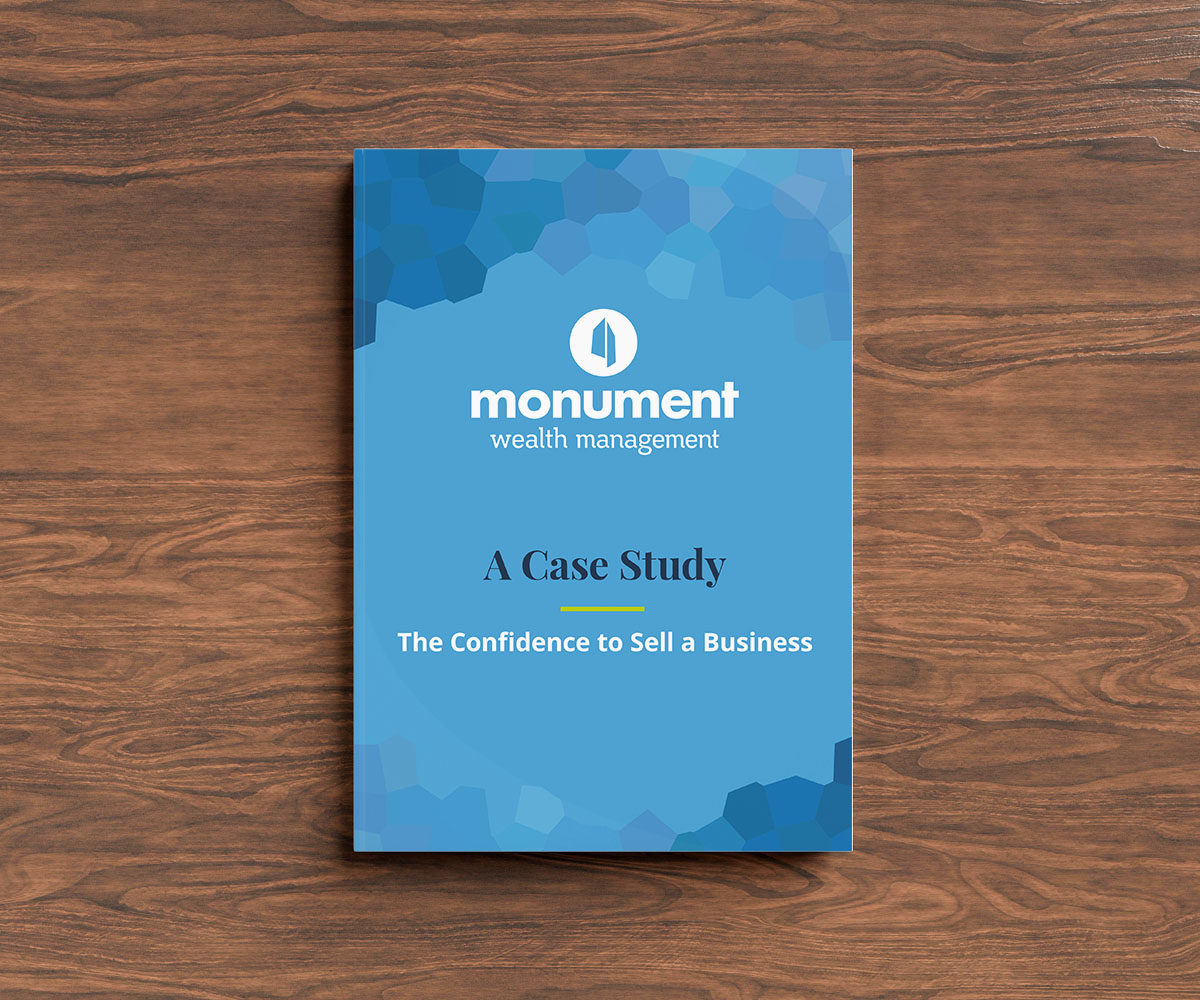Monument Wealth Management Articles
Investing for Business Owners: 4 Ways to Manage Risk and Diversify Your Portfolio

Share on your favorite platform, or by email
Entrepreneurs and business owners often approach risk differently than most, especially when it comes to their comfort with uncertainty.
As one founder put it, “The risks are endless…they never go away when you’re an entrepreneur.” This is the reality business owners face daily as they strive for growth and earnings.
Managing risk becomes even more complex when balancing a business with personal financial health. In my experience, many business owners tend to focus more heavily on their business and neglect their personal finances. While their business might be their most valuable asset, it’s essential to carefully manage their personal wealth to help reduce overall financial risks.
While there’s plenty of risk in running and owning a business, a personal investment portfolio should work to complement those risks, not amplify them.
Here are four investing tips for business owners to help manage risk and diversify:
Investing Strategy 1: Avoid Over-Concentration in a Single Sector
Business owners often find themselves overexposed to the industry they work in. Focusing on a niche can be great for a business’s growth, but can lead to over-concentration, as the business is typically their largest asset. However, waiting for a liquidity or exit event (i.e. business sale) isn’t always necessary for effective diversification—there are a handful of ways to extract value while the business is still operating.
For example, if you own gas stations, you’re already heavily exposed to the Energy sector. A downturn in gas prices could affect both your business and any Energy stocks you hold. To reduce this risk, you can diversify your portfolio by investing in sectors outside your primary industry. A wealth advisor can help you find ways to reduce your exposure to Energy stocks in your portfolio upfront and consider boosting your holdings to the other sectors. This can help balance your overall asset allocation across your financial life.
Investing Strategy 2: Transfer Value from Your Business to Your Personal Portfolio
Transferring wealth from your business to your personal portfolio not only helps diversify your investments, but it can also provide some liquidity diversification.
Most owners’ and entrepreneurs’ business interests are illiquid, meaning they can’t be quickly sold for cash. If a situation arises that requires cash, a forced sale of their ownership would likely be at a lower price than its current fair value. So, when you’re shifting value from your business into your personal portfolio, you can mitigate liquidity risk by adding assets that have relatively higher amounts of liquidity than your illiquid ownership interests. These assets might include stocks, bonds, or ETFs. These investments provide flexibility, allowing you to access funds relatively quickly and effectively without having to sell a portion of your business.
One of the goals of every investment, including a personal business, is to never be a forced seller, and having liquid investments outside your business helps lessen that risk. This is why it’s vital to have various buckets of assets with different amounts of liquidity. By diversifying liquidity in their financial portfolio, business owners can access extracted wealth without selling their ownership stake, which is hopefully going to be your fastest-growing asset.
Investing Strategy 3: Utilize Tax-Efficient Strategies Like Direct Indexing
As your business grows, an eventual sale or exit could trigger significant capital gains, resulting in a hefty tax bill. Planning ahead using tax-efficient strategies can help minimize this impact.
One option for business owners is direct indexing, a unique approach that allows investors to own numerous individual stocks that fit into their chosen investment style instead of a single fund or ETF. A strategy like this can help investors build tax assets through active tax-loss harvesting, while still aiming for index-like returns.
On average about 31% of stocks experience losses during a calendar year. Direct Indexing helps investors take advantage of this normal market volatility by actively working to capture those losses through selling stocks that are currently at a material loss, and immediately reinvesting the proceeds into other holdings that fit into your portfolio’s strategy. This process not only helps preserve your overall allocation but could potentially also build a valuable tax asset over time.
The value of these losses can be substantial and can be carried forward year-over-year if they aren’t used in a calendar year. For instance, a high earner paying a 20% federal tax rate on long-term capital gains can save $20,000 for every +$100,000 in gains offset by accumulated harvested losses. And if you’re offsetting short-term gains in the process, the savings could be even higher. Talk about a powerful use for your taxable personal portfolio!
Investing Strategy 4: Plan for an Exit Early
Entrepreneurs and owners have opportunities to diversify their wealth today and can take steps to make their eventual exit more tax efficient while they are still running and growing their business. The best financial planning for business owners, in my experience, happens well in advance of a liquidity event. Don’t wait for an exit to start planning. Instead do what you can today to be prepared. If you’ve been focused solely on your business and have overlooked your personal finances, now is the time to consider how these strategic investing decisions could impact your future.
By proactively managing risks and diversifying investments, business owners can balance their personal portfolios with the uncertainties of entrepreneurship.
Are you ready to start taking more control of your financial future? Take our quiz to see if we can help.

Read Our Case Study: Learn how a serial entrepreneur planned for the future
Ready to Design Your Future? Take our quiz.
IMPORTANT DISCLOSURE INFORMATION
Please remember that past performance is no guarantee of future results. Different types of investments involve varying degrees of risk, and there can be no assurance that the future performance of any specific investment, investment strategy, or product (including the investments and/or investment strategies recommended or undertaken by Monument Capital Management, LLC [“Monument”]), or any non-investment related content, made reference to directly or indirectly in this blog will be profitable, equal any corresponding indicated historical performance level(s), be suitable for your portfolio or individual situation, or prove successful. Due to various factors, including changing market conditions and/or applicable laws, the content may no longer be reflective of current opinions or positions. Moreover, you should not assume that any discussion or information contained in this blog serves as the receipt of, or as a substitute for, personalized investment advice from Monument. To the extent that a reader has any questions regarding the applicability of any specific issue discussed above to his/her individual situation, he/she is encouraged to consult with the professional advisor of his/her choosing. No amount of prior experience or success should be construed that a certain level of results or satisfaction will be achieved if Monument is engaged, or continues to be engaged, to provide investment advisory services. Monument is neither a law firm nor a certified public accounting firm and no portion of the blog content should be construed as legal or accounting advice.
A copy of Monument’s current written disclosure Brochure discussing our advisory services and fees is available for review upon request or at www.monumentwealthmanagement.com/disclosures. Please Note: Monument does not make any representations or warranties as to the accuracy, timeliness, suitability, completeness, or relevance of any information prepared by any unaffiliated third party, whether linked to Monument’s website or blog or incorporated herein, and takes no responsibility for any such content. All such information is provided solely for convenience purposes only and all users thereof should be guided accordingly.
Historical performance results for investment indices, benchmarks, and/or categories have been provided for general informational/comparison purposes only, and generally do not reflect the deduction of transaction and/or custodial charges, the deduction of an investment management fee, nor the impact of taxes, the incurrence of which would have the effect of decreasing historical performance results. It should not be assumed that your Monument account holdings correspond directly to any comparative indices or categories. Please Also Note: (1) performance results do not reflect the impact of taxes; (2) comparative benchmarks/indices may be more or less volatile than your Monument accounts; and, (3) a description of each comparative benchmark/index is available upon request.
Please Remember: If you are a Monument client, please contact Monument, in writing, if there are any changes in your personal/financial situation or investment objectives for the purpose of reviewing/evaluating/revising our previous recommendations and/or services, or if you would like to impose, add, or to modify any reasonable restrictions to our investment advisory services. Unless, and until, you notify us, in writing, to the contrary, we shall continue to provide services as we do currently. Please Also Remember to advise us if you have not been receiving account statements (at least quarterly) from the account custodian.
